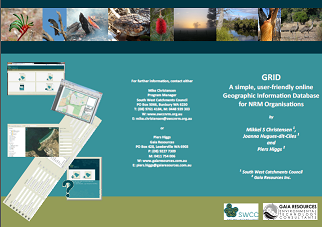I’ve just come back from the NRM Regions Knowledge Conference in Launceston, Tasmania and as usual I’ll try to wrap up a very busy trip via a blog article.
I arrived the night before the workshop day of the conference, ready to start the day by going to the “Running the NRM business” session, where Mike Christensen (from SWCC) and I presented a poster on the Geographic Reporting and Information Database (GRID).
The interesting thing about holding a conference in Launceston is that there are no venues large enough to cater for all of the delegates in multiple streams so, as a result, the delegates were spread all over the city. This was not just for the workshops, either – this also meant there were a number of smaller dinner venues that delegates were assigned to.
So once the business session was over I trekked back to the conference ‘base’ and then bussed out to the Australian Maritime College, where l sat in on the second half of the Coastal session. This session had a theme of citizen science within it, something we do a lot of work on here at Gaia Resources (l recently published an overview of our citizen science programs on this blog).
I had missed the morning session for this stream while presenting elsewhere but made it in time to hear a great presentation from Dylan Gleave (South Coast NRM) on his citizen science diving project, which, Iike many great things, started off from a discussion in a pub. This project is highly scientific, very engaging and without doubt would be one of the most well-rounded citizen science projects I’ve seen.
This session ended with an impromptu (but well facilitated by Carla Sbrocchi) discussion on citizen science. A lot of discussion covered things I thought were old ground but then I realised I’ve been working in the citizen science space with Gaia Resources for the last six years! This was a good opportunity for us all to talk about what works, what doesn’t, and what else we could do. My volunteer role with MAPSWA also came in handy: if you want to see good engagement, go talk to your local SES or BFB unit!
It was also great to see some of my fellow collaborators in the nascent Citizen Science Network Australia (stay tuned…) at this stream. There are so many projects happening in the citizen science space at the moment across Australia, it is hard to keep up – as a volunteer! (as a side note, I’m off to Dolphin Watch training tonight to become an accredited volunteer).

Launceston from the air – and no venue to seat us all for dinner
After a very enjoyable conference dinner (I was assigned to the Mud Bar on the waterfront), I missed the morning conference session to talk through some project details with a client, but made it back in time to hear the update from the federal Environment and Agriculture Departments, who covered some of the plans for the future for NRM space, most of which was “watch this space”. I also did see Dan Gregory, the CEO of The Impossible Institute (and self described “fat guy from the Gruen Transfer”) do a keynote speech. Dan’s talk about engaging with your audience resonated with me on a number of levels, from projects we run in the citizen science space through to how we run Gaia Resources more holistically.
I finished the day by attending the National Rangeland Alliance meeting, where I now represent the Rangelands NRM group on the steering committee for the new Rangeland Hub project, with the CRCSI. This will be a really interesting role, and the project looks set to deliver a range of excellent outcomes to land managers in the Australian Rangelands. I can’t wait to get stuck into this!
So, what were the take home messages from this conference for me? The main three were:
- Always deliver value that your customers appreciate,
- The NRM business is changing and evolving, perhaps moreso than ever, and
- Engagement is still the key factor for success in citizen science projects.
The conference was definitely worth the trek across the country to Tasmania, to see a range of old colleagues, new colleagues and to catch up on the landscape of the NRM community. We’ll be back for the next one!
Piers
Leave a comment below, or start a conversation with us on the Gaia Resources Facebook page, or via my own or the Gaia Resources Twitter accounts.


Comments are closed.